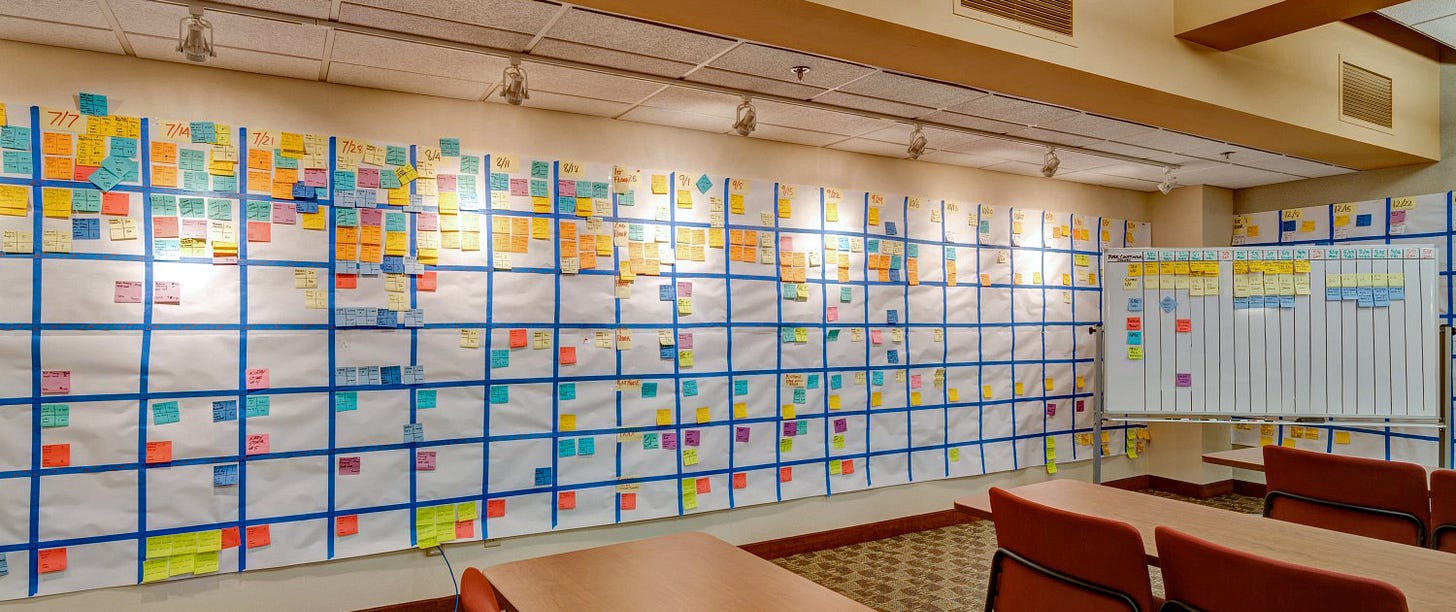13 Proven Strategies for Effective Last Planner Pull Planning
👋 Hey, Kyle here! Welcome to The Influential Project Manager, a weekly newsletter covering the essentials of successful project leadership.
Today’s Overview:
Pull planning is a powerful way to get designers and trade contractors to make commitments and help schedule the design and construction work involved in a project.
Project team members start with a milestone and then work backward logically to determine all of the steps needed to complete the work and all of the dependencies between the steps.
If your goal is to lead effectively and predict outcomes, mastering a successful pull planning session is a must. Today, we cover 13 best practices to enhance your pull planning efforts.
📅 13 Best Practices for Effective Pull Planning Sessions
Filed under: Lean Tools & Tactics
Have you ever found yourself grappling with the complexity of organizing or participating in a pull planning session?
If you're nodding in agreement, you're not alone.
Pull planning, a cornerstone of lean construction methodology, is no walk in the park. It can be tricky to get everyone on the same page and to see the whole project from start to finish. It's not just you - we've all been there.
But here's the thing: once you get the hang of it, pull planning can really make a difference.
It can help your team work together better and make your project run more smoothly. So, even though it's tough at first, stick with it. Trust me, it's worth the effort.
What is Pull Planning?
Pull planning is a component of the Last Planner System and a process many teams use to start their lean implementation journey.
Pull planning is a powerful way to get designers and trade contractors to make commitments and help schedule the design and construction work. Project team members start with a milestone and then work backward logically to determine all of the steps needed to complete the work and all of the dependencies between the steps.
These processes can break down communication barriers and build collaboration between team members.
If leading people and predicting outcomes is the goal, then it is essential that you learn how to conduct a successful pull planning session.
Having participated in countless pull planning sessions, I have identified 13 proven practices that can greatly enhance your pull planning efforts.
These practices have been refined through experience and are designed to maximize the effectiveness of your last planner pull planning sessions.
1. Open Your Mind
Achieving success in this process calls for a readiness to step out of your comfort zone and open up to a planning approach that might be new to you.
Prepare to think through activities, durations, and hand-offs, and stand by your commitment to deliver on your promises.
2. Embrace Openness & Collaboration
Pull planning requires bravery. Encourage all participants to advocate for their work and expertise during pull planning sessions. It's beneficial for everyone to approach these sessions with confidence, a collaborative spirit, and an open mind.
This is the trade partners' chance to enlighten the team about their workflow. Help each other seize the opportunity by actively engaging in discussions, rather than adopting a passive or confrontational stance.
3. Confirm Attendance
The easiest way to ensure that your pull plan sucks is by having poor attendance—or by having the wrong attendees in the room. This can easily happen when the invite comes out only a few days before the meeting.
Send invitations to trade partners at least two weeks before the pull plan meeting, and follow up with reminders. Ensure the right attendees are present for a successful session.
In the email, be clear on the following bullet points:
The date, time, and duration of the pull plan session.
The location of the pull plan (either a physical location or virtual).
The milestone that is being pulled back from.
Your expectations around who should attend and what each person will contribute.
Your team’s preliminary thoughts around work phasing and flow.
The desired level of detail that should be described for each activity.
4. Clarify Phasing and Workflow
Before setting up or participating in a pull planning session, make sure to clarify phasing and workflow direction for the team.
Phasing and flow can change during the pull plan meeting from what was initially articulated and that’s okay, that’s the benefit of having all the experts in the room for the pull plan session.
It’s just important to have thought through these things prior to the session to utilize the time effectively.
5. Conduct a Pre-Pull
One effective strategy to keep your pull plan on track is to conduct a preliminary pull plan with the core project team before involving all trade partners.
This initial session allows the superintendent and project management team to align expectations, estimate work durations, and share insights regarding the direction of workflow and phasing.
The final step in this internal pre-pull planning involves addressing the following key points to ensure clarity:
The date, time, and objective of the pull plan
Expectations about attendees and their respective contributions
Initial ideas concerning work phasing and flow
The level of detail required for each activity description
6. Understand What Milestone is being pulled
Understand the milestone being pulled and prepare to discuss your activities and durations related to it.
7. Avoid Overly Ambitious Plans
Focus on one milestone at a time and break down complex sessions over several days.
This helps maintain engagement and concentration throughout the sessions.
8. Know what needs to happen for your work to begin
On the pull plan cards, prompt the trade partners to specify the activity, duration, and hand-off. The hand-off (or predecessor) section of the card is a crucial opportunity for the last planner to articulate precisely what prerequisites need to be fulfilled for their work to commence.
For instance, if a mechanical trade partner is tasked with installing ductwork in Area A, their activity would be stated as "Install ductwork in Area B," and the hand-off might include "Shop drawings reviewed, ductwork fabricated, priority walls in place."
By incorporating these hand-offs into the pull plan cards, it compels the entire team of last planners to contemplate the necessary steps to complete those prerequisites before ductwork installation can begin. This results in a more accurately delineated schedule.
9. Provide clear and complete information
Make certain that the information shared is clear, detailed, and easily understood.
As a Project Manager, interpreting cards that have incomplete information, illegible handwriting, or lack of detail can be extremely frustrating.
Ensure that the details provided are ample enough for everyone to comprehend the task at hand and the prerequisites needed for the work to commence.
For instance, use "Apply primer to walls in Area A" instead of a vague term like "Paint."
10. Avoid concealing float or contingencies in your duration
This can be a challenging aspect for last planners. Despite the potential for delays in construction projects, it's crucial to refrain from incorporating buffers into activity durations. Instead, the focus should be on making dependable commitments during the pull plan session.
If activity durations are padded with buffers to account for unexpected conditions, it can lead to an inflated schedule. Moreover, if things proceed as planned, the subsequent trade partner may not be prepared, as the hand-off would occur prematurely.
11. Facilitate, don’t dictate
A good facilitator promotes collaboration and ensures everyone understands the plan.
The facilitator’s role is crucial to the success of the pull plan, and a good facilitator will be able to lead the team, ask the right questions, and keep everyone on engaged.
12. Two Roles for Effective Planning
In my experience, you need 2 important roles to run an effective last planner pull plan. A strong “facilitator” (as noted above) and an “engager.”
Consider starting out with your project manager acting as the facilitator guiding the meeting so it runs efficiently and your superintendent acting as the “engager” to make sure the content is the accurate and useful:
Superintendents (“Engagers”) need to be:
Actually listening and engaging with trade partners
Challenging the flow
Diving into the details
Collaboratively planning the work
Project Managers (“Facilitators”) need to be:
Organizing the structure
Staying ahead of the pull so attendees are ready for when their up
Capturing notes and important items that need to be documented
Fielding questions, keeping things on track
Supporting the attendees
13. Quick Documentation & Distribution
After the pull planning session, promptly update the master schedule, create a 6-week look-ahead, and distribute relevant information to all attendees.
This helps maintain momentum and prevents loss of critical information. Here are some quick bullet points for closing out your pull plan session without losing critical information:
Distribute photos of all pull boards for attendee reference.
Record and share any “parking lot” items discussed during the session.
Update the master schedule with details from the pull plan.
Prepare a 6-week look-ahead based on the pull plan.
For in-person sessions, tidy up the room and prep supplies for the next session.
In summary, let these 13 strategies serve as your roadmap to mastering pull planning. When you organize your next pull planning session, remember these tips and best of luck in leading your team towards successful project outcomes.
Until next week,
Kyle Nitchen

Whenever you're ready, there are 5 ways I can help you:
Get my first book! No Bullsh*t Project: A Project Manager’s Guide to Successful Project Leadership
Upgrade your scheduling software. Experience the future planning system for construction and real estate development. iPM subscribers get a 15% discount on the first year license.
Get my full toolbox (free). Access 30+ software and hardware tools I'm using today.
Learn Takt Planning. Elevate your skills as a scheduler, planner, and lean builder with the Takt Planning & Control online course. Use code "Influentialpmtakt" for 30% off.
Advertise in my newsletter. Put your brand in front of 7,000+ construction project managers, leaders, and execs. (Booked out 8 weeks)




